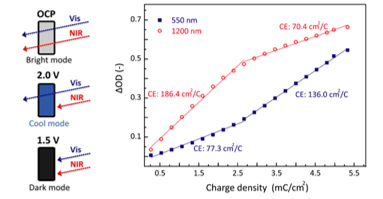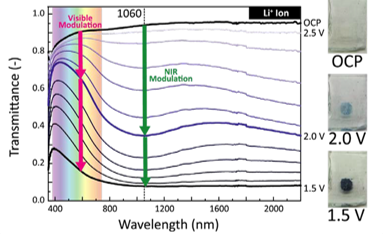Electrochromic transition metal oxide nanocrystals for inexpensive, efficient, and responsive windows
Technology description
Researchers in the group of Professor Milliron have developed low-cost glass coatings made from nanocrystal inks that control daylight and solar heat gain in buildings on demand. These smart windows can be integrated with building control systems and are responsive to preferences of building occupants.
Advantages of a nanocrystal approach to smart windows:
- Low-cost solution processing, also compatible with flexible plastic substrates
- Ready tuning of tinted color by mixing nanocrystals of different compositions in a single ink
- Dual-mode operation to selectively control visible light and infrared transmission allows optimal management of lighting and thermal loads

Figure 1: (left) Schematic of dual-mode electrochromism to selectively control daylighting (Vis) and heating (NIR), depending on the voltage applied to the coating. (right) High coloration efficiency for NIR and visible light control (vs ~50 cm2/C for industry standard)

Figure 2: Demonstration of dual-mode switching with a wide dynamic range of transmission
Features and benefits
- Improved color neutrality
- Made from commodity precursors available in bulk
- Improved stability under solar illumination
- Higher coloration efficiency enables strong modulation, faster, in thinner, more durable films
Stage of development
The technology is currently at laboratory-scale and available for technology license. Dr. Milliron is also open to partnering on scale-up and prototyping to further demonstrate the technology. IP status: U.S. patent application 17/283,089
Literature

